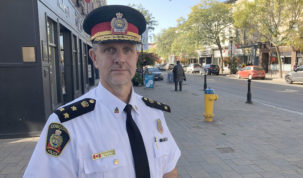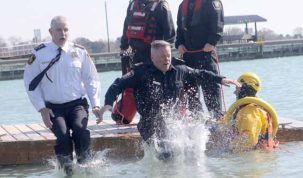
MPP David Piccini and Sarah Delicate
Cecilia Nasmith
Flood is the new fire, United Shoreline Ontario spokeswoman Sarah Delicate told Cobourg council at this week’s committee-of-the-whole meeting.
But while emergency crews are well trained to deal with fires, the uptick in catastrophic flooding since 2017 has found too many municipalities unprepared with an effective response.
Delicate’s purpose in addressing council was to explain how Plan 2014 is behind the flooding and to call for action. The attendance in the small council chambers was so dense that Mayor John Henderson let the audience know they had set up the Old Bailey Courtroom on the ground floor with live streaming of the meeting.
A flood survivor who lives in Bowmanville, Delicate explained that Plan 2014 was crafted by the six-member International Joint Commission (three American members and three Canadian) established under the 1909 Boundary Waters Treaty to govern water levels on their shared bodies of water such as Lake Ontario and the St. Lawrence River.
Inflow to these bodies comes largely from Lake Erie (85%) and Mother Nature (rain and snow). Outflow is controlled by the Moses Saunders Dam in Cornwall. When they close the dam, Delicate said, Lake Ontario rises very rapidly, and Plan 2014 dictates the point at which the dam will be opened and the high water levels relieved.
When the IJC says it is ameliorating the levels as much as possible, she said, what they are saying is that they are ameliorating the levels as much as is allowed under Plan 2014 – which allows catastrophic levels to persist for as long as five months before addressing the situation.
Typically, the IJC increases lake levels coming into spring, and Mother Nature does her bit at this time of year with rain and snowmelt.
Unfortunately, Delicate pointed out, 2017 and 2019 were high-precipitation years, resulting in months and months of high water.
Plan 2014 was supposed to be an update of Plan 1958DD, which governed the IJC for more than half a century, until 2016.
During these years, municipalities like Cobourg set policies based on the shorelines created by Plan 1958DD for such things as setbacks, boat launches, public and private docks and public infrastructures.
The new plan recognized there might be winners and losers in the new arrangement, but did strive to ensure benefits for shipping and hydro as well as the preservation of wetlands. Meanwhile, the price paid can be seen – for example – at the flooding of Cobourg’s marina that cut off electricity to boaters.
The higher water levels are based on calm waters, Delicate continued. Add in a stiff wind and two-metre swells, and the damage is multiplied.
It is estimated that about 60% of the Lake Ontario-St. Lawrence River shoreline is residential, putting more than 3,000 properties at risk of flooding. But there is also the threat to municipal infrastructure like roads and bridges and public parks, not to mention the decreased property values and economic vitality.
“Municipalities were not warned. Funds were not given to prepare, mitigate or respond,” Delicate stated, pointing out that the treaty that established the IJC did provide for damages and mitigation to any properties adversely affected.
Delicate issued a call for two actions – opposing Plan 2014 and acknowledging the new reality in terms of emergency response.
In the US, New York Governor Andrew Cuomo is tireless in speaking out against Plan 2014, and class-action lawsuits are being filed. The chair of the newest IJC (an American) is outspoken in agreement with Cuomo, but none of the three Canadians have indicated any dissent.
But at the grass-roots level, opposition is being registered. Among the voices raised are the County of Northumberland and Northumberland-Peterborough South MPP David Piccini.
As for response, she cited her own experiences in Bowmanville from 2017. Worried property owners were welcome to come to the roads depot and fill sandbags for their property, but no guidance or assistance was offered. The road sand had been combined with salt that later tainted wells, and the overfilled taut-surfaced sandbags did not settle into each other for a more solid wall and great volumes of water got through the gaps.
“Every disaster, no matter how large, starts at the local level, and it is ultimately your emergency responders who will be called to task,” she said.
“And we learned in 2017 how municipalities respond to flooding is at the discretion of council. There is no provincial policy stating what a flood-response scenario looks like.”
Clarington learned from 2017, and has been co-ordinating a municipal-response brigade of more than 100 residents who have been trained and are on rapid-notify when needed to fill and deploy sandbags. There are even high-school students volunteering, she said, and they worked hard in advance of the 2019 flood season to be prepared.
The results – in spite of four major flood events, the water was, for the most part, held back and damages were a fraction of the cost of the 2017 event.
Asked by Councillor Emily Chorley if it might not be better to revert to Plan 1958DD, Delicate agreed.
Meanwhile, she decried the perception that, because home owners chose to live on a lakeshore, flooding is their problem. If your house were near a forest and a fire started, she pointed out, fire fighters would respond immediately.
“You would never go to a fire and hand them buckets and water and say, ‘Do your best.’”
“We can and must do more at the provincial level,” stated Piccini, who was in attendance.
The MPP said there was already a meeting scheduled with three levels of government in Brighton.
“I think we shouldn’t be pointing fingers. We should be working together – provincial, Federal and municipal – to come to the table.”
Piccini pledged to send a note that very evening to Premier Doug Ford, and promised the people in the audience that they could expect more from him in the coming days.
Cobourg Emergency Planner Shannon Murphy assured the group that the town is listening to their concerns.
Meanwhile, Murphy shared details of work she is doing with other parties for a larger and more unified response in flooding mitigation and response. Municipal boundaries may be paper-thin, she pointed out, and it makes no sense to address the matter one way when, a few feet away, it’s being handled differently.
Murphy described watching the swells eroding shoreline before her eyes during a mid-June storm.
Though there is no specific flood plan, she said, the town has an all-hazards plan that involves training first responders and public-works personnel. They did put out sandbags this year.
Murphy assured members of the public she could always be reached with their concerns. However, “at the end of the day, when we are dealing with Plan 2014, this is bigger than our municipality.
“Right now we are looking at levels that are remaining high. Over the last 24 hours, it has come down one cm. – not even enough to discuss.
The concern is, we have more rain in the forecast, starting this evening. This afternoon, the waves picked up again and we are heading back in that direction.”
Chorley wondered if the town might not need a flood-specific response plan, but Murphy pointed out that the Ganaraska Region Conservation Authority has a flood plan for this area that can be called upon.
However, she added, she had been told that water levels in 2019 would not exceed the record levels of 2017. In the end, they did. And in light of that, Murphy said she would lean in that direction.
“This is a wake-up call, in my opinion,” Deputy Mayor Suzanne Seguin said.
Though director of public works Laurie Wills reassured council that the town’s road sand had no salt, Seguin pointed out that so little is commonly known about proper sandbagging.
That’s just half of it, Murphy said. There’s the removal and clean-up afterward. The sand in the bags can become contaminated, so it can’t just be dumped back into Lake Ontario.
Council passed the motion put forth by Seguin, acknowledging the record levels on Lake Ontario that are expected to persist under Plan 2014 and requesting both provincial and Federal governments to investigate the situation – especially in light of the extensive impact on shoreline communities – and to strike a committee to review mitigation and safety plans.
The motion also authorized Mayor John Henderson to work with government and other appropriate parties to address flood-mitigation measures, and called on the IJC to live up to its treaty obligations and provide protection and indemnification measures for affected properties.
Meanwhile, Henderson pointed out that, in addition to town staff, members of council had been very responsive to residents’ concerns, taking them seriously and taking the time to make visits to these properties to discuss the issue.
Chorley called on council to direct Murphy to put together a flood-specific emergency plan for the town.
“We will be doing that in-house and bringing it back separately,” Henderson said.
“I promise you, I will do that.”
Plan 2014 Not Responsible For High Water Along Lake Says Board Member
























